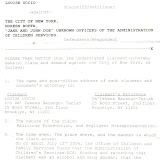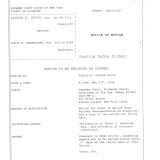So.. this is what happens to the [il]legally kidnapped children of the foster care system.
Lets not forget that these children BELIEVE they were abused... although many if not most were [il]legally kidnapped from good loving homes.. where their parents and the children were put through hell so the States could profit!
Please see those words (above) from social workers who themselves are still working within the system!
Here- Disgusted with the system: Social Workers AGAINST Child Protective Services
Too Old for Foster Care, and Facing the Recession
Even in boom times, young people who become too old for the foster-care system often struggle to make it on their own, lacking families, job skills or adequate educations. Now, the recession has made the challenges of life after foster care even more formidable, especially for those seeking federal housing vouchers, which are contingent on having an income.
Since the beginning of this year, the city’s Administration for Children’s Services has been providing letters to those about to leave the foster care system, certifying that they are likely to be eligible for public assistance and thus easing the application process when they are ready.
Yet, many child-welfare advocates worry that a growing number will still end up homeless.
“They get a lot of resources until they’re 21, and then essentially none,” said James J. Golden, the executive director of the Edwin Gould Academy in East Harlem, which provides housing exclusively to former foster children. “It’s like falling off a cliff for some of them.”
In New York, foster children are allowed to leave the system when they turn 18 but can stay until 21; last year, 407 wards turned 21, while 547 opted out early — 375 at age 18, and 172 at 19 or 20.
Once discharged from the system, some move in with family or friends, get jobs or go to college. Others apply for welfare as their sole source of income, and often end up homeless.
Administrators at the Chelsea Foyer at the Christopher, which houses dozens of former and current foster youths, said that typically, 90 percent of their residents were employed, but that in February only 70 percent had jobs.
“They are the low man on the totem pole for jobs anyway,” said Jerome Kilbane, the executive director of Covenant House New York, a nonprofit that operates shelters for young people. “Now they are even more at a disadvantage.”
Michael Smith, 20, said he was increasingly anxious as he approached the day in August that he will have to leave his foster home in Brooklyn. He has been searching for work since October, leaving résumés at places like McDonald’s and the clothing stores Express and H & M.
Mr. Smith graduated from high school in Queens in 2006 and went to Kingsborough Community College, but he dropped out after his sickle-cell anemia caused him to miss class frequently.
“I’m coming up to my 21st birthday, when I’m no longer going to be supported,” Mr. Smith said. “I feel overlooked all the times I do go apply for these jobs. But I have to do this, or else I’ll be out on the street.”
Officials at the Administration for Children’s Services say they do everything possible to avert that, including the letters that help smooth the application process for public assistance.
The child-welfare agency and the 36 foster-care groups with which it contracts begin to prepare children for independence as early as age 14. There are workshops on budgeting, job hunting, how to sign up for health insurance and how to negotiate with a landlord over rent.
At age 19, foster youths begin to talk to caseworkers about housing options, which commonly include Section 8 vouchers, public housing projects and supportive housing, where counseling and job training might be available on site.
The Administration for Children’s Services provides a one-time stipend of $750 as a cushion to foster youths when they exit the system. They are also eligible for a monthly payment of $300 from the city, from the time the leave foster care until they are 21 ½, if they are not receiving any other public housing subsidy, such as Section 8.
Most of those leaving foster care are entitled to Section 8, which typically allows tenants to rent apartments for one-third of their monthly income. But that means they need income to qualify. And with unemployment rates in New York rising precipitously, foster-care workers are worried.
“To be honest, I’m afraid that our youth are really going to be unable to secure housing,” said Jane Feyder, the assistant director at the New York Foundling Fontana Center for Child Protection. “They don’t have the work experience that other people have who are looking for jobs right now. They’re competing with so many other people who have advantages over them.”
Even advocates for foster youth acknowledge that they are a particularly difficult group to employ.
Many lack high school diplomas, having spent adolescence being shuttled from home to home. The responsibilities of a first job can come as a shock, and many quit out of frustration.
More - Too Old for Foster Care, and Facing the Recession in New York - NYTimes.com
REFRESH - Go to Home-Page
Subscribe to:
Post Comments (Atom)























No comments:
Post a Comment